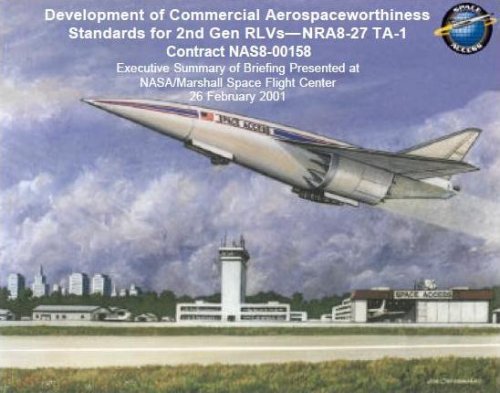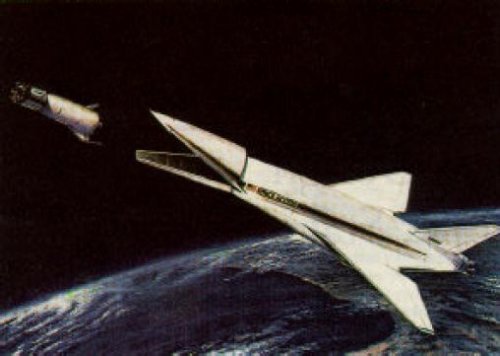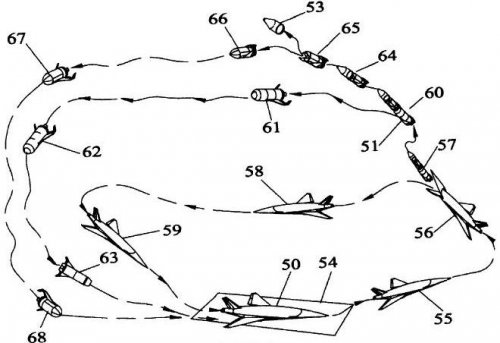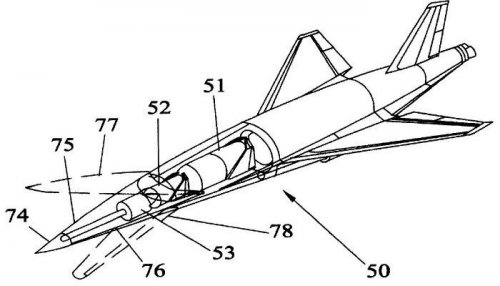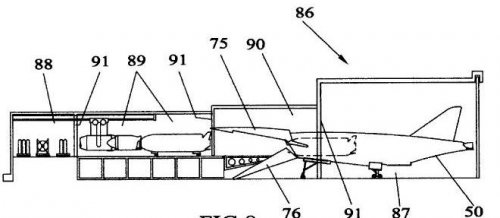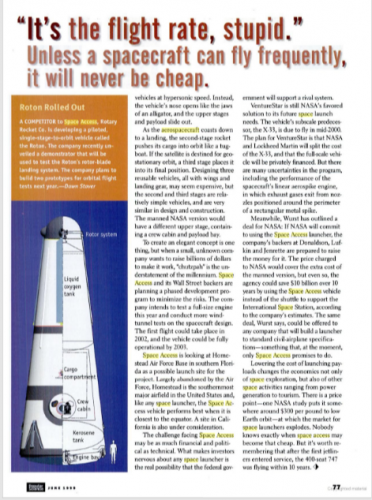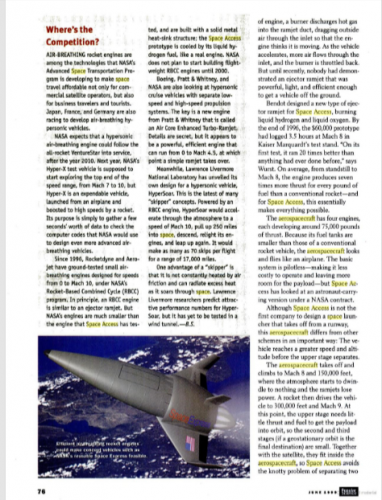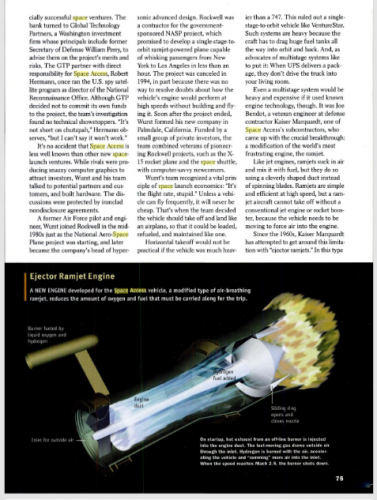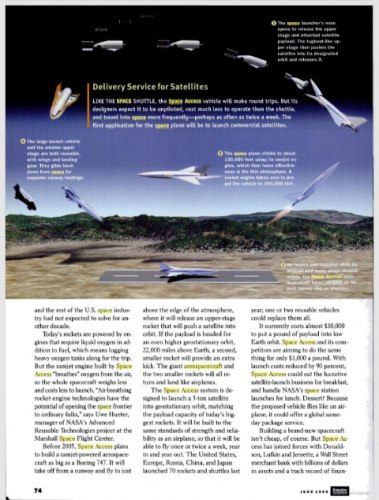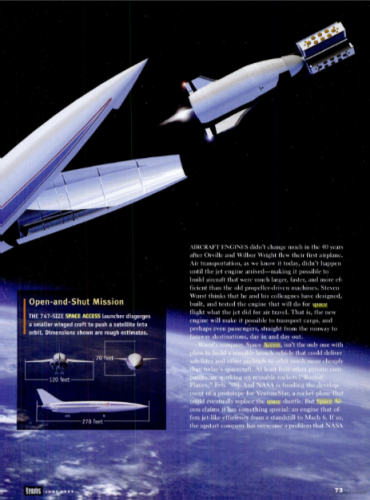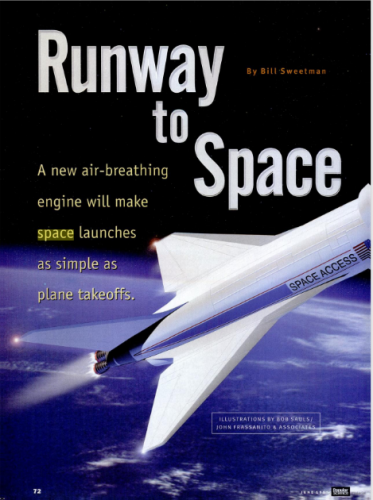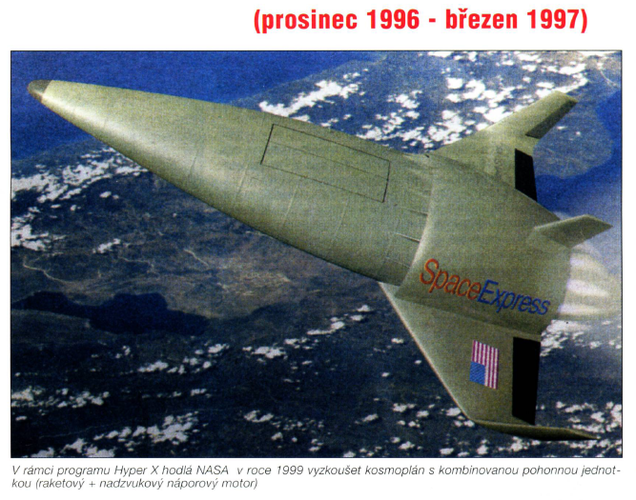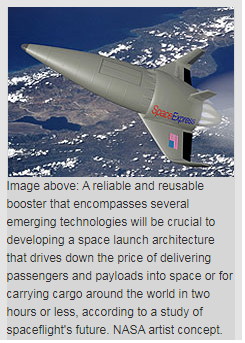FutureSpaceTourist
ACCESS: Top Secret
- Joined
- 10 March 2010
- Messages
- 589
- Reaction score
- 25
Space Access LLC was originally formed in 1994. One thing a bit different about their proposed RLVs is that they didn't only use conventional rocket engines, but instead an 'ejector ramjet' that uses liquid hydrogen fuel but oxygen from the atmosphere. Space Access claimed that the ejector ramjet is seven times more efficient than a rocket engine because the vehicle doesn’t have to carry its own oxidizer.
Here's a brief video of a ramjet test:
http://www.youtube.com/watch?v=DPZb88c1vXU
In the 90s Space Access proposed an RLV called simply the SA-1. Not many images of the SA-1 seem to be available (please contradict me if you have some!). A couple of artworks attached, apologies for the relatively poor reproduction.
The following summary of the SA-1 comes from the 2001 RLV report published by the FAA.
[quote author=FAA 2001 RLV summary]
SPACE ACCESS, LLC, is developing the SA-1, an unmanned spaceplane that uses a hybrid propulsion system and one or two rocket-powered upper stages to deliver a full range of payloads to LEO or GTO.
The entire SA-1 launch system is designed to be compliant with commercial aerospace worthiness standards, the equivalent of airworthiness standards for transport aircraft imposed by the FAA. The propulsion system for the system’s first stage, the “aerospacecraft,” is based on a proprietary modification by SPACE ACCESS to the ramjet engine design that has been in operation since the early 1960s. The modification to the engines allows the ramjets to operate at both subsonic and supersonic speeds (ramjets normally only operate above Mach 2). One of the company’s subcontractors, Kaiser Marquardt, has tested elements of the propulsion system, and SPACE ACCESS has worked with the Air Force Research Laboratory since September 1995 under a Cooperative Research and Development Agreement to review the SA-1 aeromechanics and the “ejector” ramjet propulsion system. As of March 1998, SPACE ACCESS had wind-tunnel tested the ejector ramjet engine at all of the altitudes and speeds of the SA-1’s planned flight profile.
The SA-1 vehicle will take off horizontally from a conventional runway, using a mixture of air and liquid hydrogen to power its ejector ramjet engines. As the aerospacecraft climbs and accelerates and reaches the limits of the atmosphere, it will gradually transition from ramjets to liquid rocket propulsion in order to reach its final altitude and speed of over 100 kilometers and Mach 9. The aerospacecraft will then deploy an upper stage with its satellite payload and return to land on a conventional runway. The SA-1 will carry a single, rocket-powered upper stage for LEO missions and two upper stages for GTO. After deploying the satellite payload, the upper stage will de-orbit and return to land horizontally on the same runway.
The SA-1 vehicle will be able to launch payloads of over 5,200 kilograms to GTO. Although SPACE ACCESS intends to pursue deployment of commercial geostationary satellites as its primary market, the SA-1 will also have a capability of deploying well over 15,000 kilograms to LEO as well. The SA-1’s significant payload capability and reliability, derived from being designed in compliance with rigorous transport aircraft-based standards, will also make the SA-1 well-suited for conducting resupply missions to the ISS.
In 1998, while working with NASA on a Space Transportation Architecture Study program contract, SPACE ACCESS began to study the concept of developing a crewed version of the second stage, which would give the SA-1 the capability to provide human access to space. In 2000, NASA awarded SPACE ACCESS a contract to develop Commercial Aerospace Worthiness Standards to be used by commercial RLV companies to obtain approval from the FAA to carry passengers for hire on commercial RLVs.
In cooperation with the State of California, SPACE ACCESS is now conducting tests of its proprietary integral hot structure which is based on the use of FAA-certified structural materials. SPACE ACCESS currently plans to expand its test program over the next several years to include avionics and full-scale propulsion hardware as well.
[/quote]
Here's a brief video of a ramjet test:
http://www.youtube.com/watch?v=DPZb88c1vXU
In the 90s Space Access proposed an RLV called simply the SA-1. Not many images of the SA-1 seem to be available (please contradict me if you have some!). A couple of artworks attached, apologies for the relatively poor reproduction.
The following summary of the SA-1 comes from the 2001 RLV report published by the FAA.
[quote author=FAA 2001 RLV summary]
SPACE ACCESS, LLC, is developing the SA-1, an unmanned spaceplane that uses a hybrid propulsion system and one or two rocket-powered upper stages to deliver a full range of payloads to LEO or GTO.
The entire SA-1 launch system is designed to be compliant with commercial aerospace worthiness standards, the equivalent of airworthiness standards for transport aircraft imposed by the FAA. The propulsion system for the system’s first stage, the “aerospacecraft,” is based on a proprietary modification by SPACE ACCESS to the ramjet engine design that has been in operation since the early 1960s. The modification to the engines allows the ramjets to operate at both subsonic and supersonic speeds (ramjets normally only operate above Mach 2). One of the company’s subcontractors, Kaiser Marquardt, has tested elements of the propulsion system, and SPACE ACCESS has worked with the Air Force Research Laboratory since September 1995 under a Cooperative Research and Development Agreement to review the SA-1 aeromechanics and the “ejector” ramjet propulsion system. As of March 1998, SPACE ACCESS had wind-tunnel tested the ejector ramjet engine at all of the altitudes and speeds of the SA-1’s planned flight profile.
The SA-1 vehicle will take off horizontally from a conventional runway, using a mixture of air and liquid hydrogen to power its ejector ramjet engines. As the aerospacecraft climbs and accelerates and reaches the limits of the atmosphere, it will gradually transition from ramjets to liquid rocket propulsion in order to reach its final altitude and speed of over 100 kilometers and Mach 9. The aerospacecraft will then deploy an upper stage with its satellite payload and return to land on a conventional runway. The SA-1 will carry a single, rocket-powered upper stage for LEO missions and two upper stages for GTO. After deploying the satellite payload, the upper stage will de-orbit and return to land horizontally on the same runway.
The SA-1 vehicle will be able to launch payloads of over 5,200 kilograms to GTO. Although SPACE ACCESS intends to pursue deployment of commercial geostationary satellites as its primary market, the SA-1 will also have a capability of deploying well over 15,000 kilograms to LEO as well. The SA-1’s significant payload capability and reliability, derived from being designed in compliance with rigorous transport aircraft-based standards, will also make the SA-1 well-suited for conducting resupply missions to the ISS.
In 1998, while working with NASA on a Space Transportation Architecture Study program contract, SPACE ACCESS began to study the concept of developing a crewed version of the second stage, which would give the SA-1 the capability to provide human access to space. In 2000, NASA awarded SPACE ACCESS a contract to develop Commercial Aerospace Worthiness Standards to be used by commercial RLV companies to obtain approval from the FAA to carry passengers for hire on commercial RLVs.
In cooperation with the State of California, SPACE ACCESS is now conducting tests of its proprietary integral hot structure which is based on the use of FAA-certified structural materials. SPACE ACCESS currently plans to expand its test program over the next several years to include avionics and full-scale propulsion hardware as well.
[/quote]

